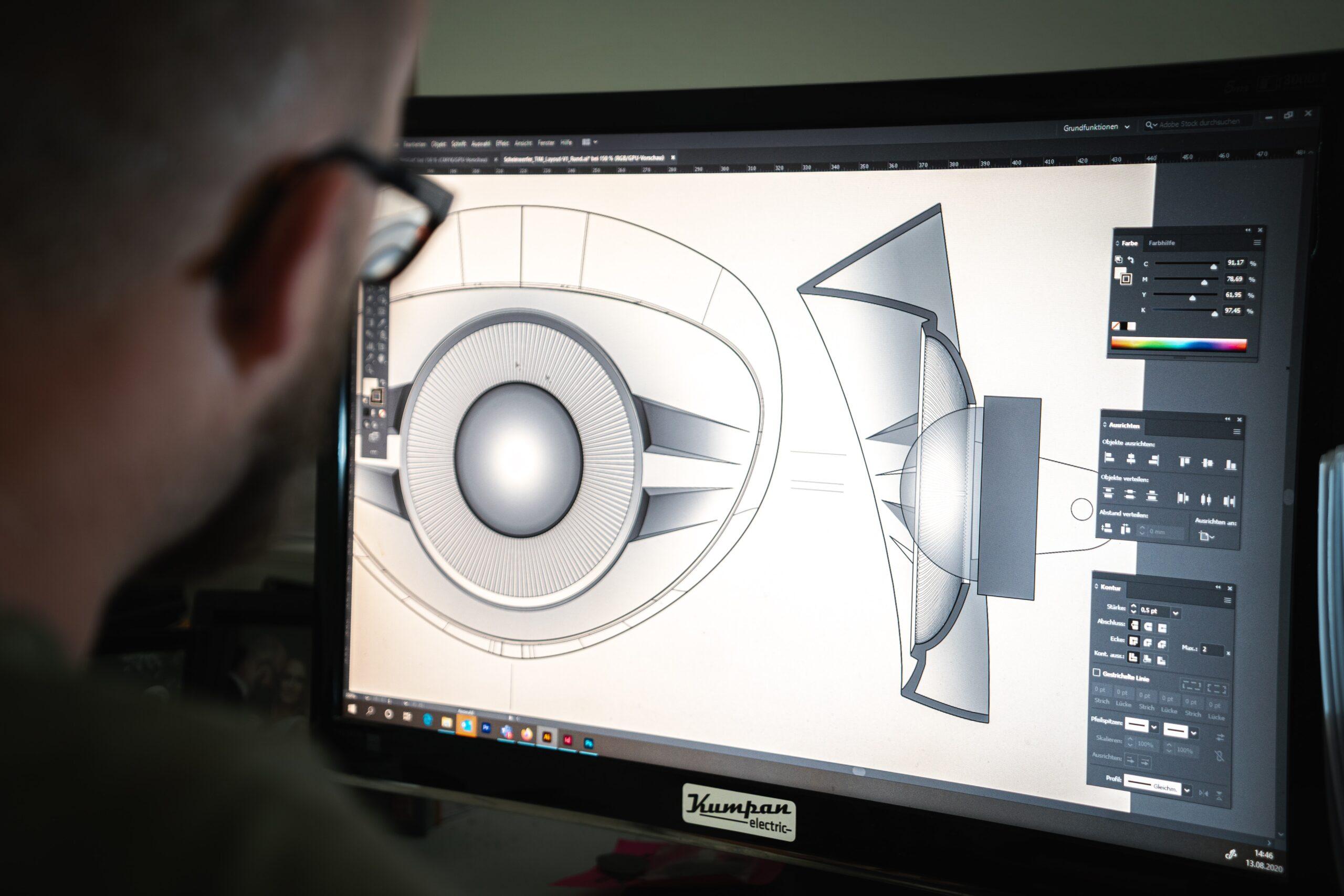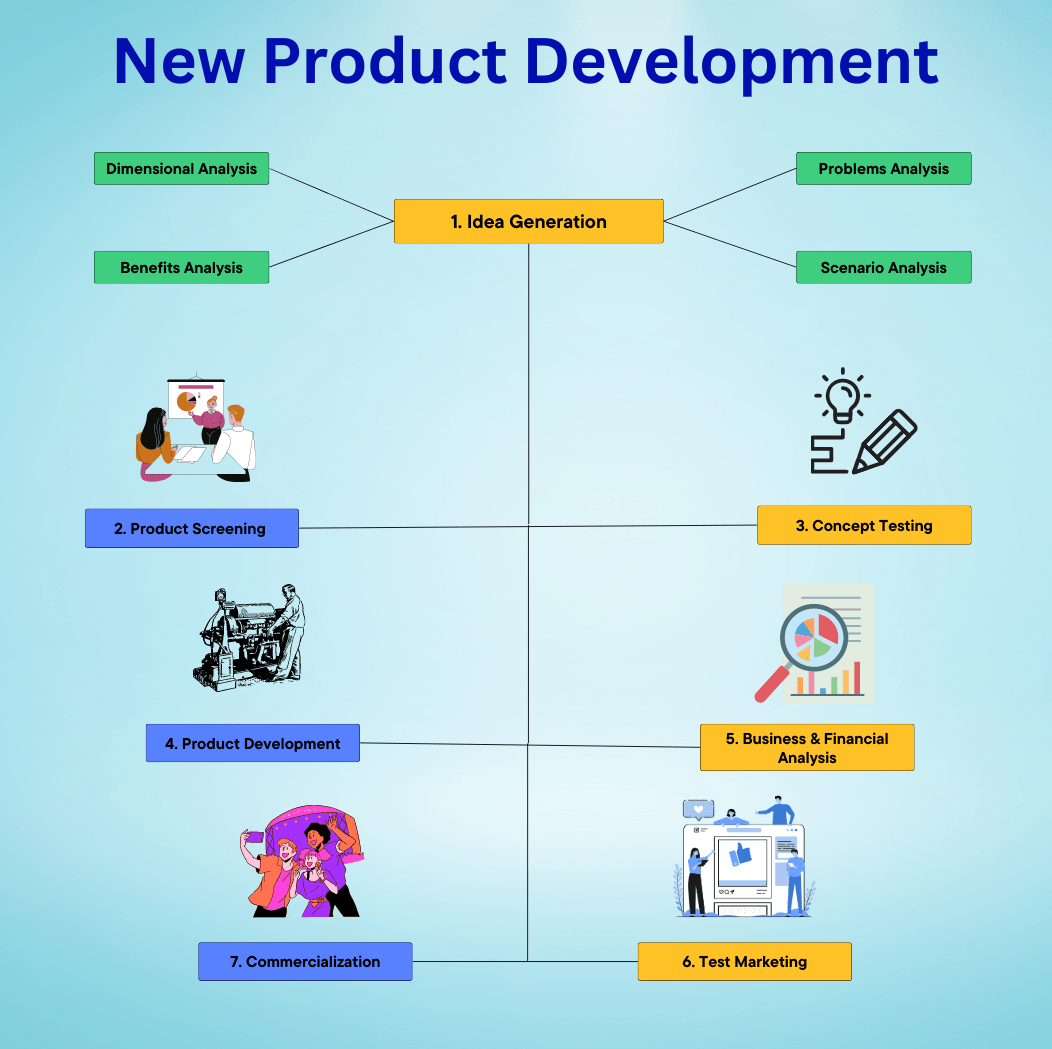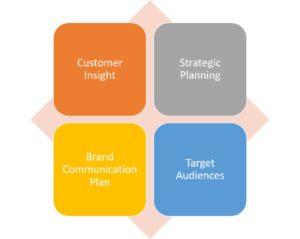New Product Development: A Step-By-Step Process

New product development is a double-edged sword. To remain relevant in the market and stay ahead of the competition, every company must continually add new products to their portfolio.
Nevertheless, the failure of a new product can be catastrophic for a business. If a new product fails, a business may incur enormous financial losses due to the substantial investments made in its development. Additionally, the company’s reputation suffers as a result of negative feedback from initial product purchasers. Lastly, if a new product fails, the company will be without a product to sell for a considerable amount of time, until a replacement product is developed.
Therefore, new product development must be taken seriously, and the process of new product development must not be compromised. This process consists of seven steps, each of which must be executed meticulously to ensure that your new product has the best possible chance of succeeding on the market and bringing you the desired returns.
New Product Development
Each of the seven steps of this process is described in detail below. To make the steps easy to comprehend, we will use the development of a new electric scooter as a central example to illustrate how each step works. Notably, this process must be kept strictly confidential to prevent your competitors from gaining access to your idea and gaining an advantage in the competition.

Also Read – Introduction to Operations Management
1. Idea Generation
This is the first and most crucial step in developing a new product, as the direction chosen in this step will have repercussions on subsequent steps. Therefore, it must be executed with the utmost diligence. In order to generate an idea that is both innovative and practical, the following four sub-steps must be followed within the idea generation step.
1.1 Dimension Analysis
In this step, we examine the dimensions of similar products currently available on the market. In layman’s terms, all the characteristics of the currently available products within the same category and segment are listed. This information then serves as the foundation for the new product, as the features or benefits currently available on the market must serve as the starting point for developing a new product concept. Dimensional analysis serves as the basis for the new product. If we are developing a new electric scooter, for instance, we must first examine all existing electric scooters and compile a list of their common features. This list serves as the foundation for the features of our newly developed electric scooter.
1.2 Problem Analysis
After completing the dimension analysis, we must examine the problems that are commonly encountered in the market’s current products. We could obtain this information by speaking with customers, trade partners, and industry professionals. This information will be useful in the future because the product developers and operations team will work to eliminate as many issues as possible to make the new product more marketable and appealing to customers. For instance, non-removable batteries and the need for a specialized charger are two major issues with the current electric scooter options on the market.
1.3 Benefit Analysis
In this section, we will present innovative and novel product-category concepts. These concepts may include new features, benefits, or pricing innovations. Again, market surveys and interactions with sales and distribution teams can provide this information. This is where our product will receive additional innovative and compelling features that will make it more appealing to customers in a competitive market. As an illustration, we may consider adding the capability to run the electric scooter on an alternative fuel for a short distance in an emergency.
1.4 Scenario Analysis
After the preceding steps, once the product concept begins to take shape, it is time to evaluate the product’s market relevance and suitability at the time of its launch. Depending on the product category, the time between the planning phase and the actual product launch can vary significantly. Automobiles may take a couple of years to develop and launch, whereas FMCG products can be developed and introduced in as little as six months. In either case, one must look into the future to determine whether the product under development will be marketable at the time of its release.
To ensure that our scooter does not become obsolete on the day of its launch, we may need to consider the prevailing environmental standards pertaining to batteries at the time of its release. Similarly, all PESTLE factors must be evaluated with an eye toward the future.
The step of idea generation is now complete, and the idea is neatly captured and presented to the evaluation team in any manner deemed appropriate for further action.
2. Product Screening
This step, also known as idea screening, ensures that all of the ideas generated in the preceding step are evaluated and the most suitable idea is chosen over the less appealing ideas. This is a formal activity in which the evaluators may come from various company departments or even from the outside. Typically, distribution partners, some loyal customers, and subject matter experts are consulted to evaluate the ideas.
The ideas are evaluated from multiple perspectives, including the operational feasibility of manufacturing the product, the availability of raw materials, the cost of the product, the dynamics of the market, and the complexity of the product. After this step, the selected concept is given the all-clear to proceed to the next phase.
3. Concept Testing
The chosen concept will now undergo concept development. The concept is refined further, and intricate details are added. As more and more people become involved in this project, the idea has been transformed into a product concept for everyone’s convenience. This idea could be presented as a 3D animation, a clay model, a demonstration, or any other medium that clearly and precisely conveys the concept. This is preparatory to the next step, in which this concept will be shared with all company departments for evaluation and future planning.
4. Business & Financial Analysis
The new product concept generated in the previous step is now shared with all the departments of the company for two reasons. One to take their valuable inputs from their perspectives, secondly to give them an opportunity to start preparing to contribute towards the product from their side. Example, the HR department may want to evaluate the availability of resources, both quantitatively and qualitatively, for handling the new product. So, they may give their inputs regarding the same and eventually start preparing to provide such resources as deemed necessary to handle the new product.
All departments are given enough time and opportunity to study the product from their perspective. This step completes with all departments giving a green light to the project. The new product concept developed in the previous step is now distributed to all company departments for two reasons. The first is to collect their valuable inputs from their perspectives, and the second is to allow them to begin preparing to contribute to the product from their end. For instance, the HR department may wish to assess the quantitative and qualitative availability of resources for handling the new product. So that they can provide their input and eventually begin preparing to provide the resources deemed necessary to manage the new product.
Each department has sufficient time and opportunity to evaluate the product from their perspective. This step concludes when all departments give the project their approval.
5. Product Development
When the approved concept is handed over to the product development team, this is a crucial step. This is when the company begins incurring enormous costs for product research and development. This step is typically considered irreversible because so much time and money have already been invested in the project.
The product development team will now create the first prototypes of the product in order to bring the concept to life. These prototypes undergo extensive internal testing until they are prepared for sampling under actual product usage conditions. This step may take from a few days to a few years, depending upon the product category.
6. Test Marketing
Now is the time to test the waters. The previously developed prototypes will now be tested under actual market conditions. There are numerous approaches. Samples of the product may be provided, as is the case with FMCG companies, or customers may be invited to try and evaluate the product, as is the case with automobile manufacturers. Test marketing strategies for new products include showroom displays, early previews, complimentary samples, and isolated launches.
The purpose of test marketing is to collect final product feedback and make any final adjustments necessary to ensure the product is completely market ready. In addition to creating suspense and anticipation in the market, test marketing provides the product with a much-needed initial boost.
Interesting Read – Creativity In Advertising – Rising Above The Din
7. Commercialization
After investing huge sums of money and intense efforts of the employees, the company is now ready to reveal its latest product to the market. This is generally done after a lot of planning. One planning point is to ensure that the product is readily available in the market for the customers to buy. Remember, there will be lot of initial traction in the market for your product due to anticipation and suspense created by the marketing team. If during this period the product is not available, the excitement dies down quickly and leaves a space in the market for the competitors to fill up with their own products.
Hence a lot of planning for manufacturing, sales and distribution is carefully conducted before the actual product launch. On the day of the launch, generally an event is organized, and a lot of media coverage is provided to announce the arrival of the company’s latest product. Celebrity endorsement, press releases, and a lot of PR are used to give the initial push to the new product.
The company is now prepared to introduce its newest product to the market, having invested vast sums of money and exerted intense employee effort. This is typically accomplished after extensive planning. One aspect of planning is to ensure that the product is readily available for purchase on the market. Keep in mind that the anticipation and suspense created by the marketing team will generate a great deal of initial traction for your product. If the product is unavailable during this period, market space is created for competitors to fill with their own merchandise.
Before the actual product launch, a great deal of manufacturing, sales, and distribution planning is conducted with care. On the day of the launch, there is typically an event and extensive media coverage to announce the arrival of the company’s newest product. Celebrity endorsement, press releases, and an abundance of public relations are used to give the new product its initial push.
Now that the new product development process has reached its conclusion, it is up to the company’s functional departments to manage the product and reap the rewards of its success.









